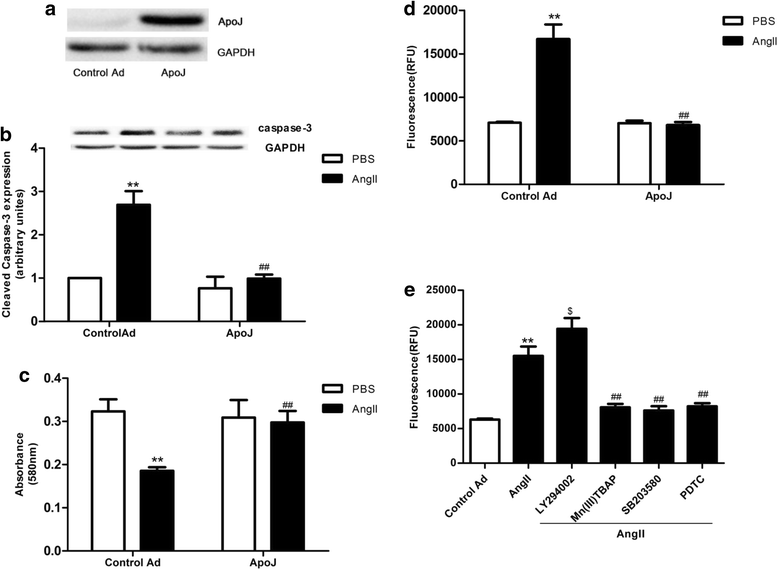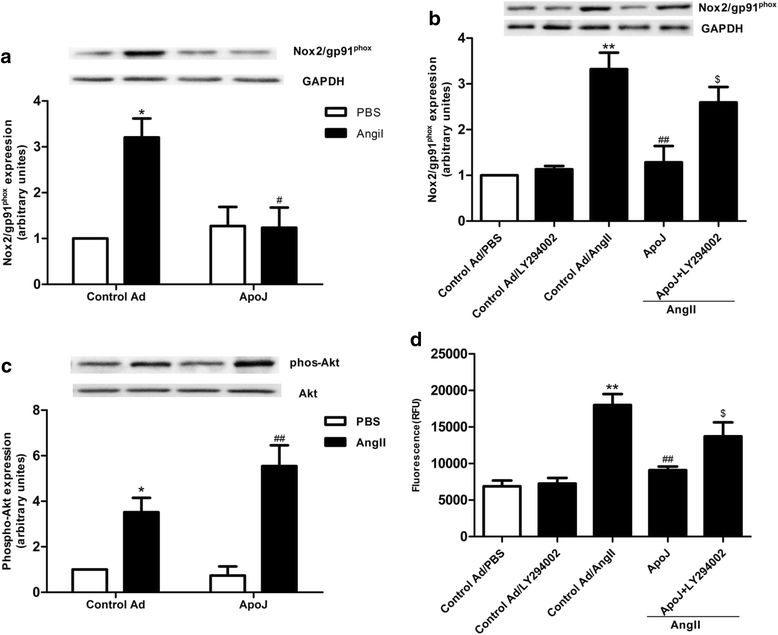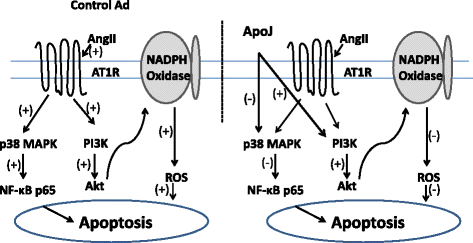Apolipoprotein-J prevents angiotensin II-induced apoptosis in neonatal rat ventricular cells
- PMID: 26391229
- PMCID: PMC4578334
- DOI: 10.1186/s12944-015-0118-y
Apolipoprotein-J prevents angiotensin II-induced apoptosis in neonatal rat ventricular cells
Abstract
Background: Up-regulation of angiotensin II (AngII) occurs in cardiac diseases, such as congestive heart failure, cardiac hypertrophy, myocardial ischemia and atrial fibrillation, which represent major health problems. Evidence from in vivo studies suggests that the level of Apolipoprotein-J (ApoJ) is also elevated but plays a protective role in cardiovascular disease. This study aimed to evaluate the protective effects of ApoJ against cytotoxicity of AngII in neonatal rat ventricular cells (NRVCs).
Methods and results: In culture, NRVCs were damaged by exposure to AngII, and ApoJ overexpression using an adenovirus vector significantly reduced the AngII-induced cell injury. ApoJ also prevented AngII from augmenting Nox2/gp91(phox) expression. The reactive oxygen species (ROS) scavenger, Mn(III)TBAP, showed similar results of attenuating AngII-induced cell damage. Furthermore, ApoJ overexpression increased phosphorylation of Akt, and the phosphatidylinositol 3-kinase (PI3K) inhibitor LY294002 diminished the antioxidant effects of ApoJ, and prevented the protective effect of ApoJ against the cytotoxicity of AngII. Moreover, upregulation of nuclear factor κB (NF-κB) p65 expression and phosphorylation of p38 mitogen-activated protein kinase (MAPK) mediated by AngII in cultured NRVCs were significantly inhibited by overexpression of ApoJ. The p38 MAPK inhibitor SB203580 and the NF-κB inhibitor PDTC protected NRVCs from injury caused by AngII.
Conclusions: ApoJ serves as a cytoprotective protein in NRVCs against cytotoxicity of AngII through the PI3K-Akt-ROS and MAPK/ NF-κB pathways.
Figures




References
-
- Schwarz M, Spath L, Lux CA, Paprotka K, Torzewski M, Dersch K, et al. Potential protective role of apoprotein J (clusterin) in atherogenesis: binding to enzymatically modified low-density lipoprotein reduces fatty acid-mediated cytotoxicity. Thromb Haemost. 2008;100:110–8. - PubMed
-
- Kim HJ, Yoo EK, Kim JY, Choi YK, Lee HJ, Kim JK, et al. Protective role of clusterin/apolipoprotein J against neointimal hyperplasia via antiproliferative effect on vascular smooth muscle cells and cytoprotective effect on endothelial cells. Arterioscler Thromb Vasc Biol. 2009;29:1558–64. doi: 10.1161/ATVBAHA.109.190058. - DOI - PubMed
MeSH terms
Substances
LinkOut - more resources
Full Text Sources
Other Literature Sources
Research Materials
Miscellaneous

